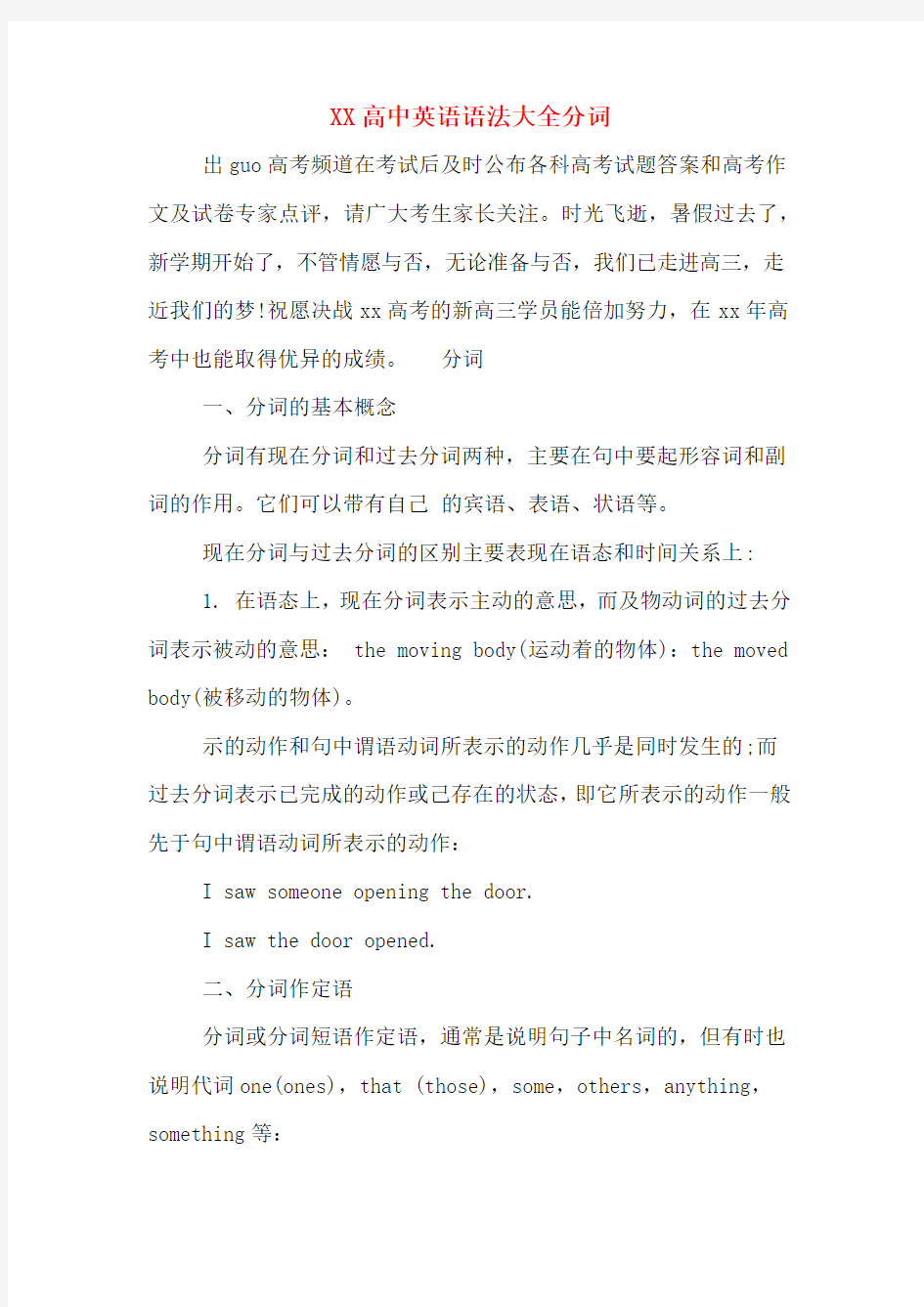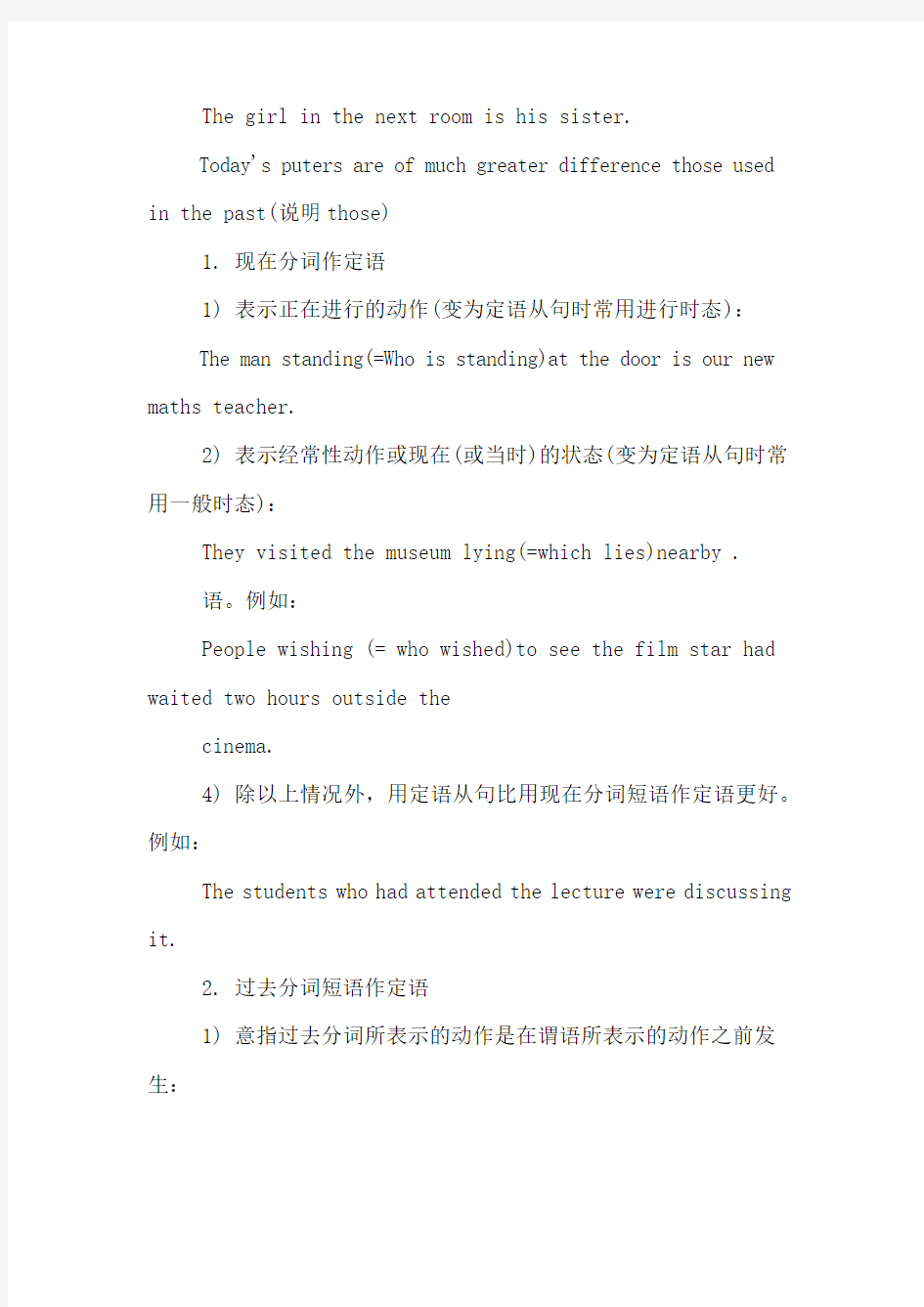

XX高中英语语法大全分词
出guo高考频道在考试后及时公布各科高考试题答案和高考作文及试卷专家点评,请广大考生家长关注。时光飞逝,暑假过去了,新学期开始了,不管情愿与否,无论准备与否,我们已走进高三,走近我们的梦!祝愿决战xx高考的新高三学员能倍加努力,在xx年高考中也能取得优异的成绩。分词
一、分词的基本概念
分词有现在分词和过去分词两种,主要在句中要起形容词和副词的作用。它们可以带有自己的宾语、表语、状语等。
现在分词与过去分词的区别主要表现在语态和时间关系上:
1. 在语态上,现在分词表示主动的意思,而及物动词的过去分词表示被动的意思: the moving body(运动着的物体):the moved body(被移动的物体)。
示的动作和句中谓语动词所表示的动作几乎是同时发生的;而
过去分词表示已完成的动作或己存在的状态,即它所表示的动作一般先于句中谓语动词所表示的动作:
I saw someone opening the door.
I saw the door opened.
二、分词作定语
分词或分词短语作定语,通常是说明句子中名词的,但有时也说明代词one(ones),that (those),some,others,anything,something等:
The girl in the next room is his sister.
Today's puters are of much greater difference those used in the past(说明those)
1. 现在分词作定语
1) 表示正在进行的动作(变为定语从句时常用进行时态):
The man standing(=Who is standing)at the door is our new maths teacher.
2) 表示经常性动作或现在(或当时)的状态(变为定语从句时常用一般时态):
They visited the museum lying(=which lies)nearby .
语。例如:
People wishing (= who wished)to see the film star had waited two hours outside the
cinema.
4) 除以上情况外,用定语从句比用现在分词短语作定语更好。例如:
The students who had attended the lecture were discussing it.
2. 过去分词短语作定语
1) 意指过去分词所表示的动作是在谓语所表示的动作之前发生:
Is this book written by the young man? A letter posted this morning will probably reach her tomorrow.
3) 动词wish,want,hope,know,think,believe,expect
的现在分词短语常可用作定2. 在时间关系上,一般来说,现在分词表示正在进行的动作或动作的进展过程,即它所表没有一定的时间性:
I don't like to see letters written in pencil.
3. 作定语时的位置
1) 单个分词作定语,常置于被说明的词之前,不强调动作而强调某种性质或特征: The cold wind was blowing through a broken window.
2) 单个分词作定语,有时放在被说明的词之后,用来强调动作: We have had good harvests for many years running. (我们连续多年获得丰收。)
3) 分词短语作定语时,通常位于被说明的词之后
三、分词作状语
分词及分词短语作状语,通常用来说明句中谓语动词。其位置
可在句首、句子中间或句末,一般用逗号分开。放在句首的常表示时间、原因、条件;放在句末的常表示结果、方式或伴随情况等。
1. 现在分词短语作状语,其逻辑主语应该和句子的主语是一致的。
1) 作时间状语,相当子when等引起的从句:
Seeing those pictures(=When he saw those pictures),he couldn’t help thinking of those memorable days in his hometown. Having done their homework(=After they had done/did their homework),they went
swimming in the lake.
如果两个动作是完全同时发生的,也常用when或while加分词这种结构: He got to know them while attending a meeting in London.
Being so poor in those days( =As they were so poor),they couldn't afford to send the
children to school.
Not having received an answer(=As she hadn’t received an answer),she wrote another
1etter to her parents.
必须注意:being短语作状语时,通常表示原因,意为“由于
某某是?”,不能理解
为“当?的时候”。
3) 作结果状语:
They opened fire,killing one of our villagers.
2. 过去分词短语作状语,句中的主语往往是过去分词的逻辑宾语。
1) 作时间状语,相当于一个表示时间的状语从句:
Seen from the hill (=When it is seen from the hill),our town looks 1ike a beautiful
garden.
2) 作原因状语,相当于一个表示原因的状语从句:
Born into a poor family(=As he was born in a poor family),he got only two years of school education.
3) 说明谓语所表示的动作发生的背景或情况:
Built in 1891, the building is over 100 years Old .
四、分词作宾语补足语
2) 作原因状语,相当于一个表示原因的状语从句:
1. see/hear/watch/notice√smell/feel/observe/listen
to/look at+宾语+现在分词: We watched the girl going through some of the movements they had just leaned. At this moment he noticed the teacher ing in.
2. catch/find+宾语+现在分词:
I caught Tom reading my diary and he made an apology to me for it.
We found a tree lying across the road.
3. have/get/keep/leave+宾语+现在分词:
I'll have the car waiting at the gate. Will that be all right?
Do you think you can get the radio working?
4. have+宾语+过去分词:其中have有三个不同的含义:
1) “使?被完成”(常可用get代替have):
I'd like to have (get) my radio repaired
2) “遭受”、“经历”(不能用get代替):
He had his watch stolen yesterday.
3) “有、拥有”:
He felt in his pocket to see if he had any money left.
5. make + oneself + known/understood/heard等过去分词: He repeated explanations,but he couldn't make himself understood.
6. with+介词宾语+现在分词或过去分词:
They sat in the room with the curtains drawn.
With the tree growing tall,we get more and more shade.
7. like/want/wish/order/+宾语+过去分词
He won't like such questions discussed in his house.
8. find或think、feel等+宾语+changed/lost/gone/broken/e 等过去分词(说明宾
语所处的状态):
We found him greatly changed. When they entered the hall,they found the guests gone. 以上有些结构可变为被动语态,其补语形式依然不变,起主语补语的作用。
五、现在分词的完成式
其形式为:having done(主动形式),表示这动作发生在谓语所表示的动作之前: Having arrived at a decision, they immediately set to work.
六、现在分词的被动式
其形式为:(以do为例)being done(一般式),having been done(完成式)。
在表示一个被动动作时,如果这动作是现刻正在进行的,或是
与谓语所表示的动作同时发生的,常用现在分词的被动式。这种形式可以用来:
1. 作定语:
This is one of the experiments being carried (= which are being carried) on in our lab.
2. 作状语:
Being asked to sing a song,he couldn't very well refuse.
间或用完成被动式:
The decision having been made,the next problem was how to put it into practice. (分词本身带逻辑主语the decision而
构成独立主格结构充当状语)
3. 作宾语补足语:
You'll find the news being talked about everywhere.
七、不及物动词的过去分词
不及物动词的过去分词没有被动意义,而是表示主动的完成的
意义:
Gone are the days when we use foreign oil.
(此句是倒装句结构,gone作表语,表示己“一去不复返了”。) You can see some fallen leaves at the corner.
这类过去分词常见的有:fallen,e,gone, risen, grown up,returned等.
象interesting和interested一类的“使役动词”的分词在意义和用法上很容易混淆,一般可作如下区分:
1. 一部分表示“情感”,“心情”等意义的动词的现在分词有“令人/使人?的”意思,常用
来说明人或事物的特征:
The president made an inspiring speech at the meeting yesterday.
2. 它们的过去分词有“感到/觉得 ?”的意思,用来指人的感觉:
这类容易混淆的分词常见的有:encouraging — encouraged; exciting— excited;interesting — interested;astonishing —astonished;disappointing — disappointed;inspiring —inspired;puzzling — puzzled;surprising —
surprised;shocking — shocked;discouraging —
discouraged;pleasing — pleased;tiring - tired;worrying —
worried;satisfying — satisfied;moving — moved; 八、容易混淆的现在分词和过去分词
内容仅供参考